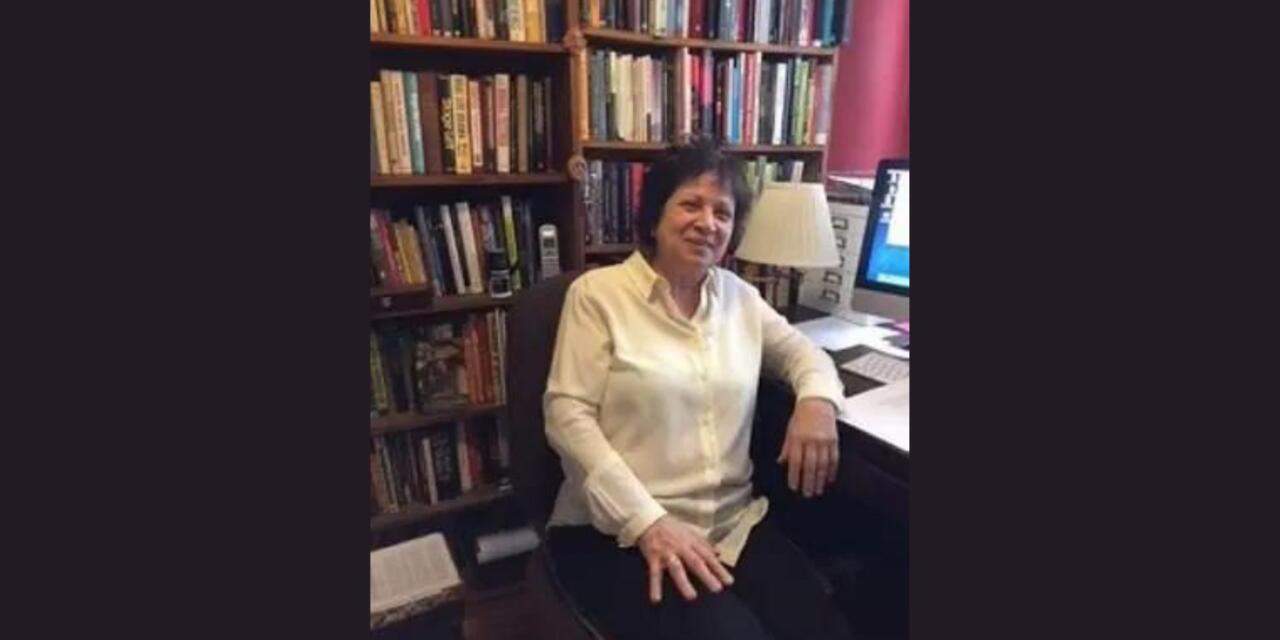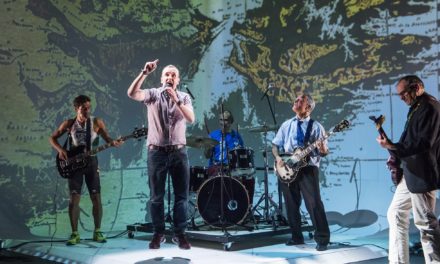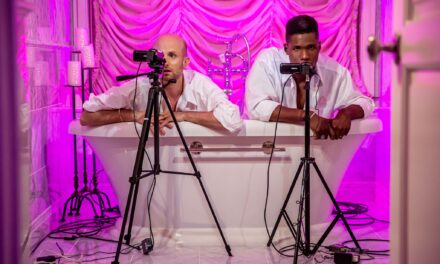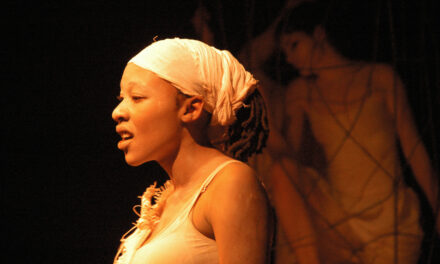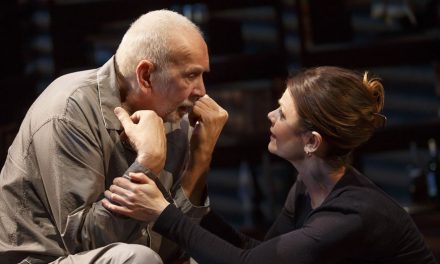Cristina Modreanu: Your new book, Timelines. writings and conversations, maps out recent developments in American and European theater but more than anything else it gives various possible answers to a deeper question: “How to be in the world today?” There are your answers, the answers of the artists you write about (Caryl Churchill, Maria Irene Fornes, Carolee Schneemann), and of those you have conversations with (Meredith Monk, Raimund Hoghe, Laurie Anderson, Gianina Carbunariu, Alvis Hermanis). Can art really answer to this quintessential question?
Bonnie Marranca: Your reading of my deepest thoughts in the book accurately highlights my questioning of how to live in the contemporary world. Whether one needs art to do that is an individual choice. But for me there is also the quest for the art of living, involving personal relationships, conversation, travel, the dining table, cultural life, and nature. For many of the artists I write about or speak to, this question is a life and death matter at the level of creation and self-expression. In some cases, they are striving to create another reality, to critique the actual world, to solve psychological, technical or artistic issues. They must do what they do.
I am attracted to thinkers as different as Albert Camus and Hannah Arendt who wrote about loving the world but keeping a solitary distance from it. They distinguished between the public and the private. I don’t believe that art can change the world, but it becomes part of the world. Artworks live their own lives in the world through time. My concern now is how to bring value and meaning to my experiences. That’s one of the reasons that I have grown less interested in the artistic process and would rather an artist speak or write about what the worldview or meaningfulness of a work is, the values and loves it is rooted in.
CM: Your book opens up with your soliloquy written in the midst of the first year of the pandemic and ends with a meditation about landscape, including a poem-like rendition of the timeline of one of your days at your home in Catskill, 125 miles from New York City, in the Hudson Valley. These are the frames of the book, atemporal and very contemporary at the same time, deeply connected not with the stage but with nature: why did you choose to do it like this?
BM: Yes, you are right that Timelines is framed by short pieces written in nature, but I didn’t plan it that way. The Preface was the last piece I wrote. It was started in the little upstate town of Catskill, where I spend several months a year, and finished months later at my apartment in New York City. In recent years I have become more and more interested in introducing the element of time into my essays for a greater sense of immediacy, so I very directly referred in the Preface to where I was and what I was thinking as I was writing it.
The last piece in the book, “Unstill Lives,” was originally written a few years earlier for Imagined Essays, a book edited by David Sack, a young theater professor. Here I chose to really think of Gertrude Stein’s idea of landscape and sit in my backyard in the countryside and record all that went on during an afternoon. As she says, “The landscape does not move nothing really moves in a landscape but things are there…” In a way, the selection is an extension of ideas I pursued in my earlier book Ecologies of Theatre.
This essay is placed at the end of the last section of my book, which is called “Writing in the Landscape.” All of the pieces in it were written about artworks or themes that occur outdoors. For example, one short essay is about a Robert Wilson installation on the grounds of the Villa Panza private art collection in Varese, Italy. Another is about a painting which depicts an outdoor summer performance of Thornton Wilder’s Our Town. In this last part of the book, I am working in a short-form, poetic style of criticism I devised for myself that brings together a single image and a text of one page or less. I am interested in developing this style of what I have in the past referred to as an “image/essay.” I would love to do more writing like this in the future, but it suits only special kinds of work.
Finally, if you look at the very end of the book, the last sentence in the last piece “Unstill Lives” is: “I move on.” This is a personal key for me. I placed “Unstill Lives” here as an ending of the book and of a particular kind of theater and performance.
CM: This year, PAJ: A Journal of Performance and Art, the Obie Award-winning journal that you founded and still edit, celebrates no fewer than 45 years of existence. When you write in the book about the moment in time when PAJ started you say: “The reigning ethos of the era in which PAJ came into being was defined by a community founded on models of collaboration and interdependence that fostered artist-run ‘alternative’ spaces and organizations, and a commitment to ‘avant-garde’ values.” What would you say is “the reigning ethos” of the American theater culture today? Which are its commitments?
BM: Today in New York and across the country the reigning ethos in theater culture is that of “diversity” and forms of identity politics. I would say that there is no widespread interest in what were once termed “avant-garde values,” in the way I had originally described. When I wrote that it was referring to the 1970s, a vastly different era, where artists and audiences were interested in experimenting with art forms and generating new modes of perception. Still, even now there is a small number of artists interested in trying to create new forms. This seems to be mostly in the realm of the technological, occasionally in writing. During the pandemic, since theater was viewed on Zoom, for the most part, it remains to be seen how much of an impact the digital world will have in creating more work for wider audiences in this form. But many people ask if this is really theater. Is there such a thing as “digital theater” or “Zoom theater”? What is the new meaning of “live?” Most of the people who work in theater that I’ve spoken to across generations have really disliked watching performance on a computer screen, though others were also grateful for archived and historical performances.
In general, there is really now a turn away from art toward the making of culture and the remaking of American society. Small theater groups are always being formed, but there is more of an attempt to fit into the system and reshape it than to remain as an independent outsider. Theaters, foundations, cultural institutions and artists are constructing their mission statements and shifting their priorities to commit to themes of social justice, in an attempt to include marginalized groups and the multi-racial society that defines America to a greater extent in theater. However, in a time of economic distress, expensive New York rents, scarcity of jobs, and the impact of the pandemic on institutions and artists, the demands of social services will impact resources for theater in the foreseeable future, challenging this goal. There is a divide between the big institutions that feature international work, like the Brooklyn Academy of Music and The Armory, and struggling downtown and off-off Broadway theaters, and the Broadway theater that runs on filling its theaters mainly with touristic audiences.
There is also unease (largely unspoken) regarding the political demands and ideological extremes of the current cultural climate. The divisiveness of contemporary American society impacts all aspects of creating, viewing, writing about and working in theater. I hope that artists and writers will have the courage to do the kind of work they want and to speak up against all forms of growing censorship and conformity. No one doubts that these are very difficult times.
CM: For years you had been teaching at The New School and you were in many ways involved in academic life, both in the U.S. and in Europe. You are rather critical in the book when you write about academia (“despite lip service to interdisciplinarity in the university, the respective academic departments remain staunchly art and theatre specializations, lagging behind a half-century model of art practice in this country”). In a nutshell, what does the U.S. contemporary academic model miss today from the point of view of theater and performance studies?
BM: I’ve written a great deal over the years about the impact of changes in academia on the curriculum, scholarship, and theater from the perspective of both my teaching and my work as an editor. To answer your immediate question, universities and colleges (though with some exceptions) continue to separate the arts in highly defined specialty departments, such as Art History, Theatre, Dance, Music, Film. More and more it is apparent that certain bodies of theory come to dominate study in each field and even certain subject matter. As an editor, I can see in the submissions of essays we receive for PAJ that there is rarely a reference to a novel, a painting, a piece of music in a theater essay. Curriculums are not fully integrated across fields and scholars have become more specialized within individual disciplines.
One of the issues that has concerned me for many years is the turn away from dramatic literature and experimental playwriting in the theater, which has moved toward more collage-like texts and fragments of multiple sources in the so-called “devised theater.” I’m somewhat tired of appropriation as a strategy in performance. Also, it is a disappointment that such collage-based texts rarely produce theater of any complexity and depth. Certainly, I am not calling for any return to a conventional theater, as the history of my publishing house demonstrates, in our more than four decades of publishing, texts of a more experimental, non-traditional nature. However, I am critical of the turn away from serious study of the traditions of drama that is necessary for an informed theater culture and the abandonment of the writer in contemporary theater in favor of the dramaturg. The conflict between Theater Studies and the rise of Performance Studies has exacerbated this situation.
In terms of scholarship, I believe that the turn since the 1980s toward making theory the center of graduate study has been detrimental to the theater. In the U.S., over the decades it has resulted in the absence of much-needed theater histories of major institutions and influential theater companies, biographies of artists, monographs and studies of writers and directors. The absence of such books makes teaching contemporary theater history difficult. Instead, advanced research and dissertations and book publication is primarily theory-driven in order for faculty and students to advance in their professions.
Due to the politicization of the curriculum and the domination of theory in the U.S., one unfortunate result in scholarship has been a weakened historical methodology. I can also see this occurring in the essays sent to PAJ. The focus is on contemporary, fashionable theories and authors and often lacks any knowledge of foundational texts in the field that are only a few decades old. It feels as though so much of the past by important writers and thinkers has been cast aside for current work that reflects accepted political positions. I’m afraid that theater people don’t seem to value important legacies in their profession.
CM: We are in the second year of the global pandemic, and normalcy is still something we try to rebuild in the theater, too. “Perhaps new forms of prayer are needed for our discordant age,” you say somewhere in your book. What about new forms of performance and new forms of spectatorship? Do you think are they as needed as prayers in this age and time? Can we, after all, do without live theater/art and live interaction in our lives?
BM: The essay you refer to, “Walking in the Woods,” is related to writing about a forest preserve established by the architect Steven Holl about a hundred miles from New York City, in the town of Rhinebeck, where he also opened an art gallery (T-Space) on his property. A few years ago, he had invited the French architect José Oubrerie to create an installation on the property. Oubrerie imagined a Chapel of the Mosquitoes! This sounded to me like a splendid Fluxus idea, “combining humor and the spiritual as a habitat for sound,” I wrote. I was also reminded of the Sacro Monte site I once saw in the Northern Italian city of Varallo that so impressed me, where small Renaissance pavilions depicting scenes from the life of Christ in frescoes and hundreds of small sculptures were built. And in many European woods and along roadsides I have seen chapels and shrines. I thought to myself, how wonderful to think of the contemporary forest preserve as a sacred space devoted to contemporary art and the spiritual. In that sense, I believe that new forms of prayer are needed for our age.
Recently, a friend and I were discussing works that have a spiritual dimension to them, mainly Jewish, Catholic and Buddhist, and we thought, how difficult it is for a work of art to achieve a spiritual energy. I mean that in the broadest poetic and philosophical sense. We also wondered: What can we ask of art? What do we want it to do for us? Must art ask questions? Offer political statements? Make us better people? Of course, we desperately need new forms of performance and new forms of spectatorship. But they must go further than moving out of the theater and becoming site-specific works, or relying on technology to compete with social media, video games and streaming services. It remains to be seen what theater will do in the post-pandemic era, what resources are available, how many artists can financially survive to stay in the profession. What need will theater serve in societies where so many people have made performers of themselves on social media? We do not yet know the new configurations of the public and the private, and therefore the role of the live encounter in our societies. We do not even know what life will be like two, three, five years from now.
Ultimately, working in the arts is not just a career, it is a way of life and thinking about the world. We need the rhetorical and artistic styles of prayer as a form of humility and aspiration and searching. We need new and soft languages and poetry and beauty even if they must confront the catastrophic imagination.
This interview was originally published by Scena.ro and has been reposted with permission. To read the original article, click here.
This post was written by the author in their personal capacity.The opinions expressed in this article are the author’s own and do not reflect the view of The Theatre Times, their staff or collaborators.
This post was written by Cristina Modreanu.
The views expressed here belong to the author and do not necessarily reflect our views and opinions.

